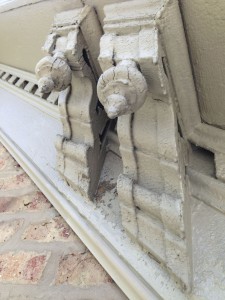In the 1880’s, it was common to adorn the façade of Chicago masonry buildings with a large wood cornice and corbels>/strong>. Our painting and decorating company recently did the restoration of such architectural elements in the Bucktown area of Chicago.
Over a long period of time and numerous coats of paint, the paint surface begins to develop small cracks in a pattern similar to the skin of an alligator. This paint phenomenon is known as “alligatoring”. If lead paint is present, which is highly likely for a building of that vintage, the alligatoring would take on more rectangular shapes. Once these cracks begin to develop, it makes the coating more vulnerable to water intrusion. After a few more years, the alligatoting begins to crack open and peal off. This is when paint accelerates and the wood becomes vulnerable to decay, since it is left open to the elements. The coating in our Bucktown cornice restoration project was in remarkably good shape, although it was badly alligatored. What steps did we take to restore this antique cornice and corbels?
First, we cleaned the surfaces by hand. Then, we scraped whatever paint would come off with carbide blades. We then primed the surfaces with an adhesive, high-built primer. We used this particular primer for two major reasons. First, the product is very thick and fills in all the alligatoring patterns and partially evens out surfaces where the paint came off. As a result, the appearance of the cornice improves substantially. More importantly, this primer has elasticity and adhesive qualities. It therefore impedes the progress of the alligatoring process. For those reasons, it is a go-to-primer in our historic restoration of wood surfaces. Finally, we used a high-built satin paint as a topcoat.
Improving the appearance and longevity of historic architectural structures and features is what our restoration work is all about.









 Follow
Follow
